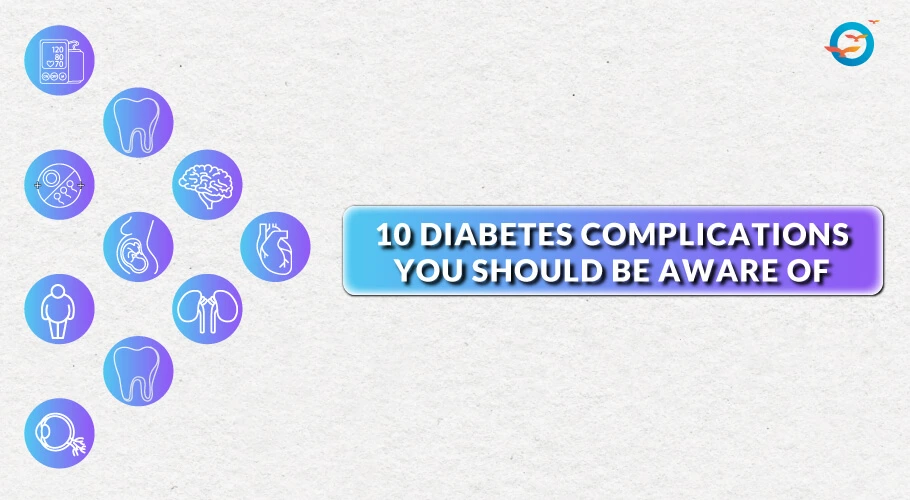10 Complications of Diabetes Mellitus

Diabetes Mellitus and Type 2 Diabetes
Diabetes is not just one of the most prevailing disorders to plague the world today, it is one that progressively brings more and more complications in its wake if left untreated or improperly treated. This is ultimate because diabetes is, at its core, a metabolic disorder, caused by the body’s inability to use the insulin produced by its own pancreas or insufficient insulin production. As glucose begins to accumulate in the bloodstream, it begins to damage the blood vessels in organs large and small across the body.
Macrovascular damage is damage to the large organs of the body, while microvascular damage refers to smaller blood vessels, which if damaged could lead to a host of complications from heart damage to problems with the kidneys or eyes of feet. The good news is that with consistent treatment and a proper lifestyle these long-term effects can be reduced or avoided altogether. In fact, diabetes itself can be reversed.
How to Reduce Complications of Diabetes?
Monitor, measure, manage
The key to avoiding long-term damage from diabetes is to know when you might be at risk. That means monitoring your body’s bio markers. Not just the blood sugar levels (BSL), which should be done as a matter of course, but also aspects like waist measurement, blood pressure, cholesterol, liver and kidney function, eye checks, etc. to ensure they are normal or within normal ranges.
- Regular Checks
Identifying potential problems early is the best way to stay clear of diabetes complications. This means you should have regular checks for markers like:
- Blood Pressure
- Blood Sugar Levels (HbA1c)
- Lipid & Triglyceride levels
- Kidney function
- Liver function
- Eyes
- Legs and feet
- Teeth and gums
Healthy diet
Diabetes itself is brought on primarily through a bad diet—rich in fat, salt, sugar, refined carbohydrates, processed foods, etc., and low in essential vitamins, minerals and other micronutrients. Working with a dietician can help you work out a healthy diet plan that factors in your individual challenges, such as allergies, as well as dietary preferences.
Weight loss
One of the imperatives in controlling BSL is weight—to be precise fat around the midsection. Shedding even a fraction of the excess fat will reduce BP, blood glucose, and cholesterol. To bring your diabetes under proper control, it is critical that you consider factors like GI ratings of foods, carbohydrate & calorie content, portion size, and nutrients in the foods you eat. Here too, a dietician is invaluable in creating a realistic meal plan.
Exercise
The connection between exercise and diabetes cannot be over-stressed. Urban living has brought unimaginable convenience to the lives of every human on the planet. Unfortunately, it has also made us very sedentary. Video games have replaced physical playground gaming, and walking and biking even to the neighborhood grocery store are, thanks to Amazon, things of the past.
Everyone must get at least one hour of physical exercise every day. And we don’t mean strolling to the pub. Walking is a great activity but it is not exercised. Ideally, you need to have a mix of strength training exercises, cardio-vascular movements and flexibility, and balance exercises. Exercise is also a great way to de-stress.
Smoking
If there’s just one habit everyone—diabetic or otherwise—must break, it is smoking. Smoking negates all the good done by your diet, exercise, etc. it affects your blood circulation, nervous system, increases cholesterol, and narrows arteries. It creates the ideal conditions for heart attacks and strokes.
Alcohol
While there is a lot of white noise surrounding alcohol consumption—with regular quaffers citing positives and doctors prescribing it—there is substantial research to show that long, and unmanaged term use of alcohol leads to serious health problems.
Limit alcohol intake. If you do like your tipple, don’t indulge in more than the standard recommended two 30 ml drinks a day or a couple of pints of mild. If you’ve already been diagnosed as diabetic, it is better to abstain altogether. Remember it is nothing but empty calories—the last thing your body needs.
The Major Long Term Health Risks of Diabetes
As mentioned earlier, the long term health complications associated with diabetes fall into two major categories:
1. Macrovascular complications:
brought on by damage to the large blood vessels of the brain, legs, or heart
2. Microvascular complications:
Caused by damage to the small blood vessels in organs like the eyes, kidneys, feet, nerves, etc.
Other organs and systems, i.e. digestive, reproductive, immune systems all fall into one of the other of the above categories. Frankly, no part of the body is immune to the effect of high blood sugar.
Here are the 10 Most Common Complications of Diabetes Mellitus
1. Diabetes and Alzheimer's Disease

There is sufficient evidence to show that there is a definite connection between Type 2 Diabetes and Alzheimer’s disease. The primary reason is simply insufficient blood supply or high-glucose content in the blood that leads to damage of the blood vessels in the brain. High blood sugar levels are also known to lead to thickening of arterial walls which ultimately increases the risk of stroke.
This is a major contributing cause of mental disorders like Alzheimer’s. Age and genetics are big risk factors, with research showing that people with a parent or sibling suffering from Alzheimer’s is at greater risk of developing the same problems. But there is a lot one can do to reduce the risks. To read more about the link between Alzheimer's and diabetes click here
2. Diabetic Nephropathy
Long-term diabetes if uncontrolled leads to damage of the small blood vessels in the kidneys. Patients aren’t usually aware of the damage as it is painless and shows few symptoms until it gets serious. This is why regular health screening of kidney function is very important.
Early detection is key to avoiding kidney damage, or nephropathy. Diabetics should also actively work to reduce risks through an exercise-diet regimen that helps normalize their blood pressure. To read more about Diabetic nephropathy click here
3. Diabetes and Cardiovascular Disease

Heart disease, which includes blood vessel disease, cardiac arrests, and stroke, is a primary cause of death the world over. Diabetics are higher at risk of contracting heart disease, for a number of reasons. But all is not doom and gloom. There are some immediate steps you can take to reduce the risks. For instance:
Stop smoking, keep your blood pressure under control, monitor and manage your cholesterol levels, and, above all, check your HbA1C levels regularly—once a year if you’re not diabetic, and every three months if you suffer from diabetes. To read more about Link Between Diabetes & Cardiovascular Disease Click here
4. Diabetic Retinopathy

Sustained high blood sugar levels (BSL) cause damage to the small blood vessels of the eye and nerves as well this. This brings a variety of vision problems, such as cataracts, glaucoma, and macular oedema (swelling of the macula in the retina caused by fluid build-up).
While these problems are usually symptoms in the early stages, you should watch out for symptoms like light flashes, blots in from of your eyes or if a portion of your vision is missing.See your doctor immediately. Regular eye examinations are a must to avoid vision problems, especially as one grows older. This is especially true for diabetics. Think you could be at risk? To read more about Diabetic Retinopathy Click here
5. Diabetic Neuropathy

One of the most common problems that diabetics face is loss of sensation to the extremities—hands and feet, This can begin with tingling or burning sensations and progress rapidly from there. This damage occurs as a result of nerve damage to the feet and hands, which is itself a result of reduced blood supply and reduced nerve function.
This lack of sensation often leads to ulcers and other foot problems. You can address this easily through regular visits to a podiatrist, checking your feet daily for cuts and blisters, and wearing comfortable and supportive shoes that fit well. The ideal solution, of course, is prevention. To read more about diabetic neuropathy click here
6. Diabetes and Oral Health
Poorly managed diabetes increases the risk of oral problems like tooth decay and gum infections. This is caused by damage to the blood vessels that supply nutrients to the teeth and gums.
The opposite is also true—gum infection can lead to high blood sugar levels.If you’re diabetic, oral health should be high on your list of things to do. You can start by taking a big bite To read more about Diabetes and oral health Click here
7. Diabetes in Pregnancy
Pregnancy is said to be one of the most fulfilling periods in a woman’s life. But if the expectant mother happens to be diabetic, this can also be a very challenging time. Pregnancy also carries the risk of gestational diabetes—a type of diabetes that usually afflicts first pregnancies.
Gestational diabetes usually goes away after delivery, but it can come back later as Type 2 diabetes. However, the real threat is to the unborn child, as high BSL during this period can lead to birth defects in the heart, brain or spine. And there are also chances of stillbirth and miscarriages. To read more about Diabetes in Pregnancy click here
8. Diabetes and infertility

Male potency is directly related to the volume of blood supply that reaches the penis. Erectile dysfunction, which refers to a a person’s continuous inability in reaching or maintaining an erection, is not an uncommon phenomenon. But while any male can suffer from this once in a while, it is seen more often in diabetics.
This is because of the physical damage to the blood vessels in the genitals. Sexual dysfunction can affect both males and females—though it is more commonly reported in males. Knowing what’s causing the problem and how to address it can help you resolve it too. To read more about diabetes and infertility click here
9. Diabetes and Hypertension
When glucose builds up in the bloodstream, which is a direct result of insulin insensitivity, it damages every organ where the blood supply reaches. One direct result of this high glucose content in the blood is that blood vessels begin to thicken.
This reduces the volume of blood that can flow, in effect, increasing the pressure with which blood flows. This is similar to pinching a water hose to increase the force with which it flows out. As arterial walls thicken, the heart is forced to pump with more force. High BP is a leading cause of stroke and brain damage.
Unfortunately, it doesn’t show any early symptoms, which is why it is often referred to as the silent killer. The root cause of BP, like diabetes, is insulin resistance. Treating this can reverse both problems. To help you come to grips with this insidious disorder, we have put together this article. To read more about diabetes and hypertension relationship Click here
10. Obesity and Diabetes
Diabetes is a huge problem—pardon the pun—across the world, and its dimensions are growing with each passing day. Urbanization has brought unimaginable convenience, but it has also turned the world’s citizens into sedentary, couch dwellers who prefer to get their adrenalin up in the digital world than the playground. The result is a growing pandemic of obesity. And it is debilitating, not just to the phenomenal physical problems it poses, but the diverse health risks it brings—the biggest of which are insulin resistance and BP.
Obesity is the biggest contributor to diabetes. When fat in the midsection accumulates around visceral organs, it compromises their functionality. The liver and pancreas, for instance. It also gets into muscle cells where it wraps havoc by preventing glucose from the blood to enter the muscle cells.
The result is higher glucose in the bloodstream and higher secretions of insulin, which further hastens fat conversion. And it’s not just the very chubby among us who are at risk. You can be relatively slim and still be at risk from obesity. Find out if you have any risk factors and how you can address obesity. To read more about the relationship between obesity and diabetes Click here.
Conclusion:
Yes, diabetes is a growing global problem. And yes it is responsible for a diverse array of health complications. But diabetes and its attendant health complications can be addressed. Conventional medicine long held that diabetes was for life. But we know now that this is just not true. At FFD, we have experienced phenomenal success in completely reversing not just diabetes but the health problems it brings too.
Over 11000 diabetics to date have successfully freed themselves of the physical and financial burden of diabetes, and tens of thousands more have reversed problems like BP, cholesterol, obesity, PCOD/S, and more, through our reversal programs like the online Holistic Transformation Program and Transformative Residential Program (TRP). If you or a loved one is suffering from diabetes or any of the complications discussed here, contact our office today. Life can be sweet again.
FAQs
What is diabetes mellitus?
Diabetes mellitus is a metabolic disorder where the body cannot effectively use insulin or produce enough of it, leading to high blood sugar levels.
Can diabetes complications be prevented?
Yes,it is possible with healthy lifestyle, regular checkups, and medication, diabetes complications can often be prevented or reduced.
What are the microvascular complications of diabetes?
Microvascular complications involve damage to small blood vessels, leading to issues like retinopathy, neuropathy, and nephropathy.
How can I monitor my diabetes effectively?
Regularly check blood sugar levels, HbA1c, blood pressure, cholesterol, and organ function, and consult your doctor for guidance.
Why is exercise important for diabetes?
Exercise improves insulin sensitivity, helps control blood sugar levels, reduces weight, and enhances overall health.




